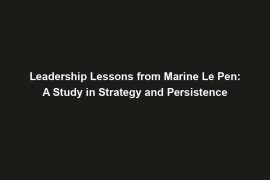Hey there, history buffs and aspiring leaders! Today, we’re diving into the fascinating life and leadership of Adolphe Thiers. Don’t worry if you’re not familiar with him – we’ll give you a quick rundown of his background and why he’s worth knowing about.
Adolphe Thiers was a prominent figure in French history, serving as a key leader during a time of great upheaval and change. His ability to navigate turbulent waters and guide his people through challenging times has made him a figure worth studying for anyone interested in leadership.
So, what’s the point of this blog post, you ask? Well, we’re here to explore the valuable lessons we can learn from Thiers’ life and actions. By delving into his story, we can uncover insights that can help us become better leaders in our own right.
In the sections to come, we’ll be discussing three key lessons that stand out from Thiers’ leadership style. We’ll talk about his embrace of change and innovation, his talent for building bridges and fostering unity, and his knack for balancing realism and idealism. Trust us, there’s a lot to unpack here!
So, grab a cup of coffee, settle in, and get ready to glean some wisdom from one of history’s most intriguing leaders. Let’s dive into the world of Adolphe Thiers and uncover the leadership lessons that can still resonate with us today.
Embracing Change and Innovation
Adolphe Thiers was not one to shy away from change. In fact, he embraced it with open arms, recognizing that adapting to new circumstances was key to success as a leader. Whether it was implementing new policies or adopting innovative strategies, Thiers was always willing to pivot when necessary. This flexibility and openness to change allowed him to thrive in the ever-evolving political landscape of his time.
Anecdote:
Imagine you’re on a road trip with a GPS guiding you to your destination. Suddenly, you encounter a road closure and need to find an alternative route. Adolphe Thiers would be the kind of leader who doesn’t panic, but instead quickly adjusts the route to reach the destination efficiently. This ability to adapt and innovate on the fly is a valuable lesson we can all learn from.
Building Bridges and Fostering Unity
One of Thiers’ greatest strengths as a leader was his ability to bring people together. During a time of great division and strife in France, Thiers worked tirelessly to reconcile various factions and unite the French people under a common cause. By building bridges and fostering unity, he was able to navigate through turbulent times and lead his country towards a brighter future.
Anecdote:
Think of Thiers as the peacemaker among friends who navigate conflicts and bring everyone back together after a disagreement. His skill in fostering unity and promoting collaboration is a powerful lesson for leaders in any setting, whether it’s in a boardroom or a community organization.
Balancing Realism and Idealism
Thiers was a pragmatic leader who understood the importance of taking practical steps to achieve his goals. At the same time, he also had a vision for a better future and was not afraid to dream big. By striking a balance between realism and idealism, Thiers was able to inspire others while also grounding his leadership in practicality.
Anecdote:
Picture Thiers as a tightrope walker, carefully balancing between the practical steps needed to stay on the tightrope and the lofty vision of reaching the other side. This ability to navigate between realism and idealism is a crucial lesson for leaders who want to make a lasting impact while staying grounded in reality.
Stay tuned for the next section where we’ll wrap up these leadership lessons and explore how you can apply them to your own leadership journey.
Conclusion: Reflecting on Adolphe Thiers’ Leadership Lessons
As we wrap up our exploration of leadership lessons from the life of Adolphe Thiers, it is clear that his legacy offers valuable insights for modern leaders looking to navigate the complexities of leadership in today’s world.
Recap of Key Lessons
Thiers’ ability to embrace change and innovation, build bridges and foster unity, and balance realism with idealism all serve as powerful examples of effective leadership strategies. By adapting to changing circumstances, bringing people together, and finding the right balance between practicality and vision, Thiers was able to lead France through tumultuous times with resilience and determination.
Applying Lessons to Your Own Leadership
Now, it’s time for you to reflect on how you can apply these lessons to your own leadership practices. How can you embrace change and innovation in your organization? How can you build bridges and foster unity among your team members? And how can you strike the right balance between realism and idealism in your decision-making processes?
By learning from Thiers’ example, you can become a more effective and impactful leader, capable of guiding your team towards success and making a positive impact in your organization and beyond.
The Enduring Relevance of Historical Perspectives
It is important to remember that historical perspectives, such as those offered by Adolphe Thiers’ life and leadership, can still hold relevance in shaping contemporary leadership strategies. By studying the successes and failures of leaders who came before us, we can gain valuable insights that can help us navigate the challenges of leadership in our own time.
So, as you go about your own leadership journey, remember to look to the past for inspiration and guidance. By learning from the experiences of leaders like Adolphe Thiers, you can cultivate the skills and mindset needed to lead with courage, compassion, and wisdom.
Thank you for joining me on this journey of exploring leadership lessons from history. I hope you feel inspired and empowered to apply these insights to your own leadership practices. Here’s to embracing change, fostering unity, and finding the balance between realism and idealism in our quest to become better leaders.



